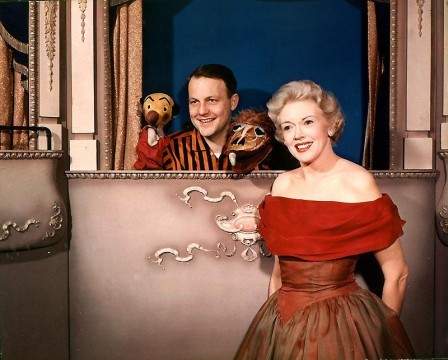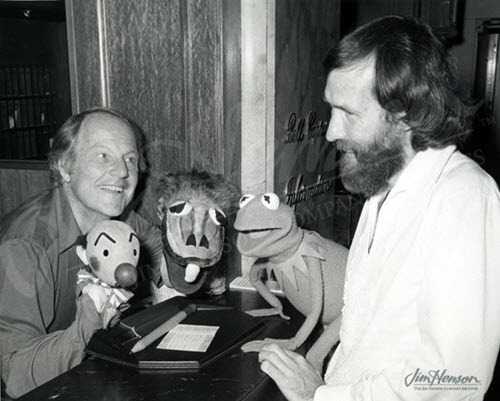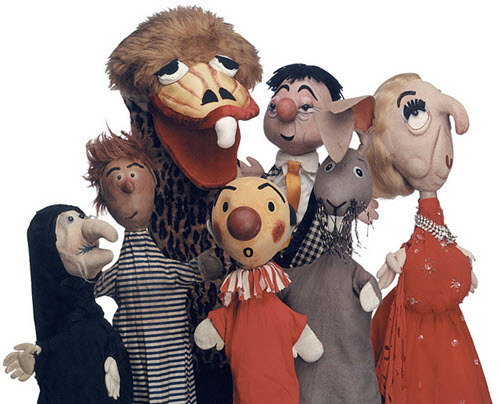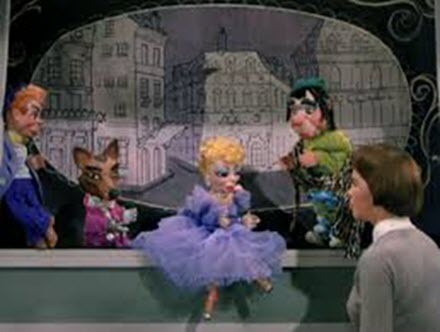As I've mentioned often, I love Edgar Bergen and Charlie McCarthy (and Mortimer Snerd). The only other that equals them for me is Burr Tillstrom and Kukla, Fran and Ollie.
I've tried to find video of the Kuklapolitan Players online, and there is some, but unfortunately none of it does the show justice. It's all very short clips, and while they're fun they're note just quite right -- some don't have Fran, or they leave out Kukla, or are just songs, or are appearances on other shows, or doing commercials. The thing about Kukla, Fran and Ollie that makes them so special, though, is that what Burr Tillstrom did is create a little world where all the characters interact intricately with one another, a world that exists on its own terms separate from the reality around them, where there's so much affection between all the characters, but still has it's fair-share of lunacy and snarkiness. And it's all tied together with the remarkable skill of Fran Allison who interacts with them so flat-out, other-worldly impeccably that you sense if she believes the Kuklapolitans to be absolutely, undeniably real, then why not you? And ultimately, the show was as much for adults as little kids with its sly references and subtly, building a story slowly over time -- which is one of the main reasons, too, why short clips don't work.
Not to worry, I do have some clips below at the end. They just don't...well, do the show justice.
The thing about Kukla, Fran and Ollie that bowls me over is the brilliance of Burr Tillstrom. It's easy to look at the old (and short) videos and not pay close attention and be dismissive. Most of the Kuklapolitans don't have mouths that move, and the few that do move (Ollie, for instance) don't do so with the impeccable syncing we've come to expect from the highest of the craft, like most notably Jim Henson's Muppets. In fact, sometimes Ollie's mouth is even closed for a word or two when he speaks. This sort of thing bothered a friend of mine who at one point had done a little bit of puppetry. I said it missed the point of what Tillstrom was doing -- and why he won three Emmys, two Peabodys and remains beloved after 60 years.
Edgar Bergen, for example, wasn't technically impeccable, often having his own characters chide him for being able to see his lips move. Yet Bergen was idolized (Jim Henson dedicated The Muppet Movie to him), and that was for the characters he created, fully believable and richly developed with lives of their own. We adored the characters. If his lips moved, so what?
And that's the same with the Kuklapolitans, as I mentioned. It's just as vibrant and substantive. But also, what tends to get overlooked, because it's all out of sight and done with such seeming ease, is that all the characters, each of them unique, are done by Burr Tillstrom (other than Fran, of course...) -- many scenes often juggling four or five characters at a time, or more, shifting voices throughout, having rapid-fire arguments back-and-forth between them and not missing a trick. It's masterful craft, seamless and brilliant. And made all the more so when you also discover that all the shows were ad-libbed. There was a general plot outline, and they rehearsed the songs with long-time music director Jack Fascinato. But that was it. He was making up with the wit, whimsy and charm on the spot. It's largely why Burr Tillstrom was also idolized.
Several years back, I happened to be in Chicago when the Chicago Historical Society had a 50th anniversary tribute exhibition on Kukla, Fran and Ollie, since the show was originated and broadcast from the city and where Burr Tillstrom lived. The exhibit was a joy. They had the original puppet stage -- which you could walk behind and see how all the puppets hung there for Tillstrom to grab and quickly put on. And all the original puppets were on display. They also had video monitors playing episodes throughout the museum. And it was filled with memorabilia, history, and more, making the world of the Kuklapolitans come alive. (The Television Academy in Los Angeles had a tribute, as well -- held alas when I was in Chicago. A friend went, and said the huge auditorium was packed...and laughing uproariously at the episode being showed with Madame Ophelia Oglepuss trying to organize the Kuklapolitans to put on one of her annual fine art operas, more often than not Gilbert and Sullivan. A video monitor at the museum event had excerpts from that same episode -- it was indeed laugh-out-loud funny, cracking up the TV crew in the background, who didn't know what was coming.)
How talented was Burr Tillstrom? The exhibit also had the Joseph Jefferson Award won by Madame Oglepuss for her performance as Best Supporting Actress in a Musical, for A Little Night Music!! Honest. Not only is that remarkable on its own merits, but you must understand that theater is a huge deal in Chicago, and the Jefferson Award is significant, the city's version of the Tony. Back in the 1970s (or perhaps early '80s), a local, well-regarded theater company was putting on Stephen Sondheim's musical and asked Burr Tillstrom if he'd participate and have Madame Oglepuss appear each night as the grandmother -- a role played in the original Broadway production by Hermione Gingold and in the recent revival by Angele Lansbury, He agreed -- and the museum had the Joseph Jefferson Award on display, to Madame Ophelia Oglepuss, to prove it.
For me, though, my biggest treat of the exhibit was seeing the puppet for my favorite Kuklapolitan, Cecil Bill. (Pronounced "Sess-uhl.) Tillstrom rarely used Cecil Bill on the show, probably because the little guy was so different and nuts that it would overdo his charm and lunacy if he was on too much. That's because Cecil Bill almost lived in his own world and spoke his own, insane language, comprised largely of different incarnations of "toi-ta-toi-toi toi". But what most thrilled me seeing Cecil Bill up close was to discover the attention to detail that Tillstrom had done with the puppet to subtly enhance the sense of how lunatic Cecil Bill was -- unlike all the other puppets, he had painted Cecil Bill's mouth just slightly off-center, making him look a bit odd, even if you didn't quite know why.
These are only some of the Kuklapolitans. A few others made appearances from time to time, notably Ollie's niece Dolores, and his mother. (By the way, that's Cecil Bill second from the left. Notice his askew mouth.) And Jefferson Award-winner Madame Oglepuss is on the right.
How real was the world of Kukla, Fran and Ollie? Oddly enough, my often-mentioned here friend Nell Minow fits in this tale, as well. Her father Newton -- later FCC Chairman under President Kennedy -- was Burr Tillstrom's attorney. (Of course, how could a Nell Minow story be otherwise...?) And since the Kukla, Fran and Ollie show was done in Chicago, one day her father had business with the puppeteer and took his young daughter to the studio. As it happened there was a newspaper reporter there doing an article on Tillstrom and the show, and when seeing a little girl, the reporter asked her some questions, one of which was the standard, "What do you want to be when you grow up?" And her answer was, "I want to be a Kuklapolitan." The quote made it into the paper.
(Side note: I've told Nell that with all the many jobs she does, and overlapping her life between the reality of big business and the fantasy world of movies, and all points in between, mixing it all up with often the unlikeliest of coincidences and events, I think she made it,)
Tillstrom's final Emmy Award came for a non-Kukla, Fran and Ollie appearance, one of the "hand ballets" he would occasionally perform on the satirical news series, That Was the Week That Was. It was for a moving piece done with nothing more than his empty hands, inspired by an actual event in the news of the time when the Berlin Wall was lowered for just one weekend during Christmas 1963.
Finally, there's a fascinating addendum to all this.
You may know the Tony-winning musical, Carnival! It's the show that introduced the song, "Love Makes the World Go Round," and was recently revived by the New York Encore! series with Brian Stokes Mitchell and Anne Hathaway. What you may not know is that it's loosely based on -- or "inspired by" is the better term -- Kukla, Fran and Ollie! Here's how the lineage works out --
Carnival! is based on MGM's classic Oscar-winning movie, Lili (perhaps best remembered for its Best Song-winner "Hi Lili, Hi-Lo"). It's the story of a young, naive girl who gets caught up with a traveling circus in Europe and becomes so enamored by its puppet show -- though not its embittered puppeteer -- talking with the puppets so deeply as if they were real, that the circus's owner puts them all together as an adorable act.
But wait, that's not the full story...
The movie, Lili, you see, was in turn based on a novella, Love of Seven Dolls, by Paul Gallico (author of The Snow Goose), which he had expanded from his short story, The Man Who Hated People, This original short story took place, not in Europe, but in a television studio in the United States, and it told about a bitter man who could only express himself with warmth through his puppets on a TV show, and the young woman who spoke with them as if they were real. If you think that that might just be coincidence with Kukla, Fran and Ollie, know this -- when Gallico adapted the short story into the novella, he moved the tale to Europe -- and dedicated it to "Burr Tillstrom and Fran Allison"!
(Know that Tlllstrom was not embittered, nor did he hate people. It was just Gallico's way to add a dramatic element to the story.)
And lest you think the connection simply ends there, here are the puppets in the movie, Lili. Compare them almost spot-on to the picture above of the Kuklapolitans.
That's Carrot Top, Reynardo the Wolf, vain ballerina Marguerite, and gentle giant Golo -- the equivalents of Kukla, Oliver J. Dragon, opera diva Madame Oglepuss, and her blustering gentleman friend Col. Crackie. And Lili, of course, played by Leslie Caron standing in for Fran Allison.
Which brings us at last to the videos. There are DVDs available, but as I said, I couldn't find any online clips that do Kukla, Fran and Ollie justice. But at least this first one has the show's sweet theme song, and a montage of all the Kuklapolitan Players in action - as well as being in color from its later years.
Next is a video from one of Madame Oglepuss's preparations for her annual Gilbert and Sullivan operetta, with the participation of Beulah Witch. It's also shows the Fran Allison's sweetness and total belief in the puppets. And shows Burr Tillstrom at his lunatic. (Much as there appears to be a happy accident in this clip, upon watching repeated viewing I'm pretty convinced that it was all impressively planned.)
And finally - this is Burr Tillstrom alone, without Kukla, Fran and Ollie. It's his remarkable, aforementioned "Berlin Wall" piece that won him a 1964 Emmy Award. As I said, he did periodic "hand ballets" on the series, That Was the Week That Was. The introduction explains the setting, though there are glitches in the old film. Just know that it's based on a then-current event when the Berlin Wall was temporarily lowered for the weekend to allow those in West Berlin to briefly visit their families in East Berlin for Christmas.
If there are any doubts of Burr Tillstrom's brilliance among those who will not see, this should put them all to rest.
*
Robert J. Elisberg's comic novel, A Christmas Carol 2: The Return of Scrooge, is available in paperback and ebook edition. It is currently #4 for Humor/Parody on Amazon Kindle.




